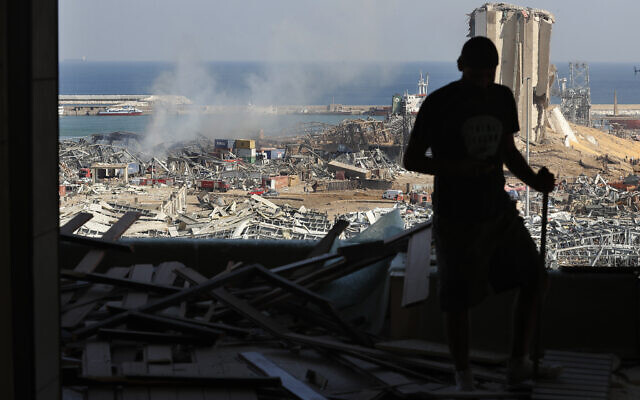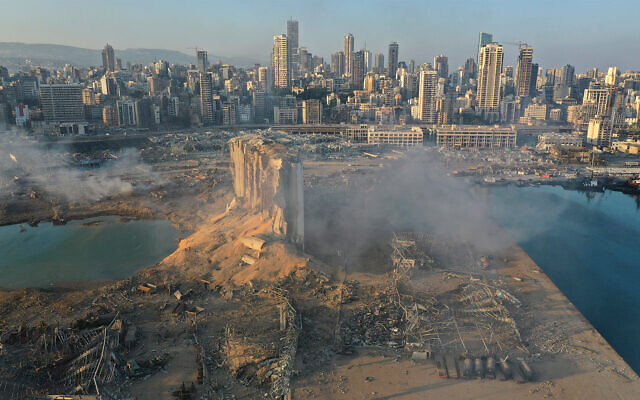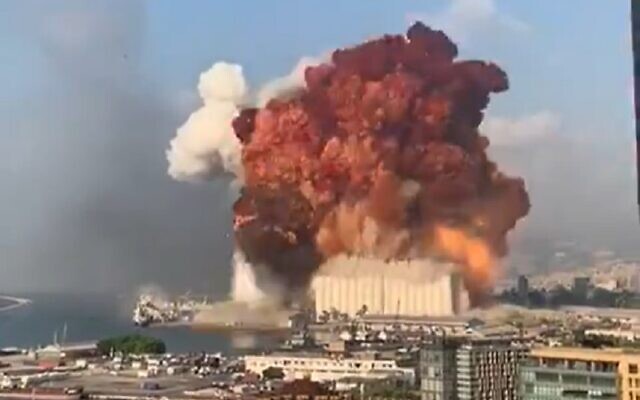The chronology of Lebanon’s singular disaster runs through the ship MV Rhosus, its allegedly dodgy owner, a volatile cargo and a blatant disregard for danger by authorities

In October 2013 the MV Rhosus, a ship sailing under the Moldovan flag, headed from Georgia to Mozambique carrying a huge supply of ammonium nitrate, a volatile chemical commonly used in fertilizers. Then, unexpectedly, the Rhosus diverted to Beirut in what was to be a short stop.
Instead, the ship was held by port authorities over irregularities, in what evolved into a months-long legal saga between authorities and the vessel’s Russian owner, and set off a chain of events that now appears to have been behind Tuesday’s deadly explosion that has devastated the Lebanese capital.
Though the Lebanese government is still investigating the exact causes of the blast and has given no official ruling, multiple media reports have pieced together how the events leading up to the disaster may have unfolded, highlighting alleged neglect on all levels and across the timeline of events.
Lebanese authorities have said 2,750 tons of ammonium nitrate that ignited in a warehouse at Beirut’s port were behind the enormous explosion that killed at least 135 people and wounded about 5,000, while displacing some 300,000 whose homes were rendered unlivable by the blast and the ensuing shockwave.

Sources in the government have indicated that the explosive material had been stored at the port for years after being seized from a ship. Media reports have now tracked the nitrate back to the Rhosus and its ill-fated detour to Beirut nearly seven years ago.
In 2013 the Rhosus was owned by Russian businessman Igor Grechushkin as it made its journey from Georgia’s Black Sea port of Batumi to Mozambique — carrying 2,750 tons of ammonium nitrate.
According to the New York Times, the Rhosus was a rickety ship, perhaps as much as 40 years old, and poorly maintained. Grechushkin is reported to have failed to have paid crews’ wages in the past.
Mozambique was not notified of a ship bound for its shores with 2,750 tons of ammonium nitrate, which ignited and exploded in Beirut, with great devastation.https://t.co/T1gBgpjZl9
— Jasmine Opperman (@Jasminechic00) August 5, 2020
There are conflicting reports as to why the Rhosus changed direction mid-journey. Some media reports have blamed technical difficulties, while others say Grechushkin ran out of funding and instructed the mostly Ukrainian crew to head to Lebanon to pick up additional cargo in order to finance the voyage.
But upon docking in Beirut the Rhosus ran into further trouble. The Seafarers’ Union of Russia told CNN this was due to the ship being deemed unseaworthy, in addition to complaints against the owner by the crew and a failure to pay port fees. The New York times reported that the ship had a hole in its hull that required water to be continuously pumped out.
The ship’s captain at the time, Boris Prokoshev, has said Grechushkin then abandoned the ship and the crew, failing to provide them with any assistance, financial or otherwise. He has called the stay at the port a form of “incarceration.”
The crew of Rhosus 8Ukrainian 2Russian men was forced to stay on board of the vessel while the owner Grechushkin declared himself bankrupt & abandoned the ship
Lebanese authorities agreed to let 6out of10 sailors to leave the country others were left stranded on the ship for2014 pic.twitter.com/2lA35N9aWs— Dr.Sabine kik (@KikSabine) August 6, 2020
“I wrote to Putin everyday… Eventually we had to sell the fuel and use the money to hire a lawyer because there was not help, the owner did not even provide us with food or water,” Prokoshev told Echo Moscow radio Wednesday.
A maritime website reporting on events at the time said the crew was sitting on “a floating bomb.” At one point Prokoshev told Russian journalists: “The owner has abandoned the ship. The cargo is ammonium nitrate. It is an explosive substance. And we’ve been abandoned. We’ve been living for 10 months on a powder keg.”
Eventually the sailors were allowed to leave and return to their homes, while the ship and its cargo remained at Beirut’s port. Reports indicate the cargo of ammonium nitrate was unloaded sometime in 2014 and placed in the port’s Warehouse 12, where it languished without appropriate safety precautions until Tuesday’s fire and subsequent explosion.
Undated photos have now emerged claiming to show the sacks of nitrate stacked together inside the warehouse.
رئيس الحكومة اللبنانية: انفجار العاصمة نتج عن 2750 طنا من نيترات الأمونيوم في مستودع بمرفأ بيروت pic.twitter.com/cX6ofAcVYs
— Fatma Saad (@FatimaS07269762) August 5, 2020
The Rhosus, meanwhile, remained forgotten at the port and is believed to have sunk some two or three years ago. Radio Free Europe reported that crew members claim Grechushkin still owes them tens of thousands of dollars in unpaid wages. Grechushkin is reported to currently live in Limassol, Cyprus, and has so far not commented on the events of recent days.
In the wake of the explosion, Lebanese authorities have placed current and former port officials put under house arrest.
The Russian channel publishes the image of the owner of the ship from which the ammonium nitrate was confiscated in Beirut 2013 Igor Grechushkin a Russian from Khabarovsk &the ship was transporting the shipment from the Batumi port in Georgia to Mozambiquehttps://t.co/pMWr36XwRs pic.twitter.com/dWawSQetes
— Ayman Abdel Nour (@aabnour) August 5, 2020
But customs officials at the port have said that far from being complacent, they repeatedly warned government officials of the great danger posed by the thousands of tons of explosive materials held at the port.
Documents show customs officials in recent years made up to six requests to judicial officials asking that the ammonium nitrate be moved, citing port safety.
One 2016 letter seen by Al Jazeera said: “In view of the serious danger of keeping these goods in the hangar in unsuitable climatic conditions, we reaffirm our request to please request the marine agency to re-export these goods immediately to preserve the safety of the port and those working in it, or to look into agreeing to sell this amount’to the Lebanese Explosives Company.”
In another purported letter circulating online, Lebanon’s customs director since 2017, Badri Daher, warns of the “dangers if the materials remain where they are, affecting the safety of [port] employees” and asked the judge for guidance on what to do with it.
“We requested that it be re-exported but that did not happen,” Daher told Lebanon’s broadcaster LBCI Wednesday. “We leave it to the experts and those concerned to determine why.”
The port’s general manager Hassan Koraytem told the NY Times: “We were told the cargo would be sold in an auction. But the auction never happened and the judiciary never acted.”
Citing a port source, Reuters reported that as recently as six months ago, a team of inspectors had warned that the stowed nitrates could “blow up all of Beirut,” but no action was taken.
Though potentially highly destructive, ammonium nitrate does not typically detonate easily and requires another ignition source.
According to LBCI, that may have happened Tuesday when welders came to close off a gap in Warehouse 9. That warehouse is believed to have stored fireworks. A spark from a welder’s torch is suspected of setting off fireworks, with the ensuing fire spreading from Warehouse 9 to Warehouse 12 and igniting the nitrates, leading to the most destructive single explosion in the country’s history.

As reported by The Times of Israel
